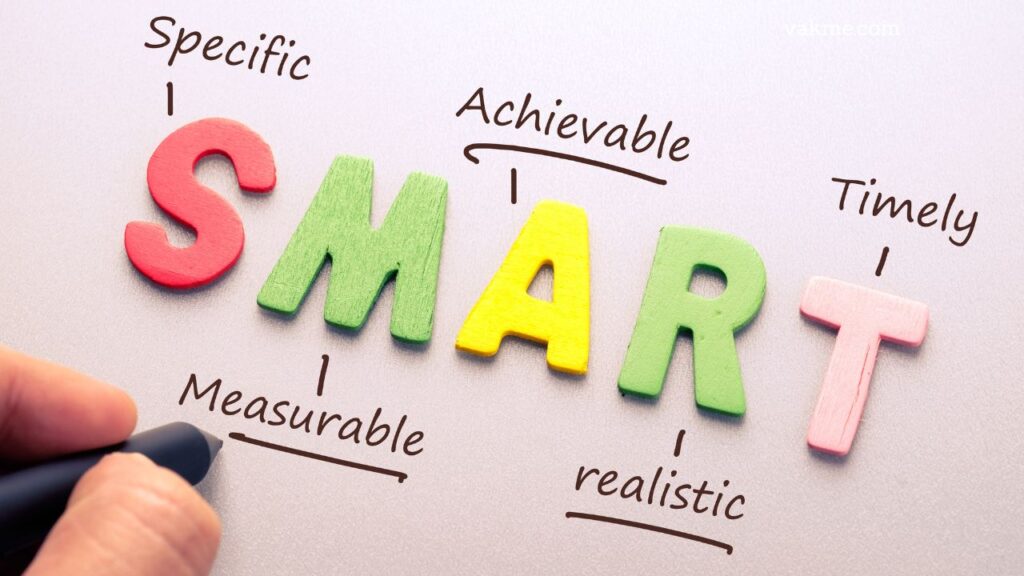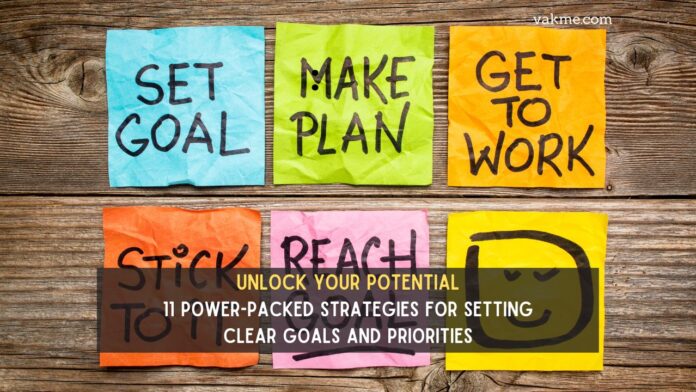Setting clear goals and priorities is the cornerstone of success in any endeavor. Whether you’re aiming for personal growth, career advancement, or business success, having a well-defined roadmap can make all the difference. In this article, we’ll explore 11 actionable strategies to help you set clear goals and priorities effectively.
1. Define Your Vision
Before setting specific goals, envision your desired outcome. What do you want to achieve? Define your long-term vision and aspirations clearly. Visualizing success can provide motivation and clarity when setting smaller, actionable goals.
Example: If your vision is to become a successful entrepreneur, visualize the type of business you want to create, its impact, and your desired lifestyle.

2. Set SMART Goals
Use the SMART criteria (Specific, Measurable, Achievable, Relevant, Time-bound) to create clear and actionable goals. Ensure each goal is specific, quantifiable, realistic, and aligned with your overall vision. Setting SMART goals increases clarity, accountability, and motivation.
Example: Instead of a vague goal like “improve sales,” set a SMART goal such as “increase monthly sales by 20% within the next quarter by implementing targeted marketing strategies.”
3. Prioritize Goals
Not all goals are equally important. Prioritize your goals based on urgency, impact, and alignment with your vision. Identify high-priority goals that contribute significantly to your long-term success. Focus on goals that align with your values, strengths, and growth opportunities.
Example: Prioritize goals that directly impact your career advancement, personal development, or business growth, allocating resources and time accordingly.

4. Break Down Goals into Actionable Steps
Break down larger goals into smaller, manageable tasks or milestones. Create a step-by-step action plan to achieve each goal systematically. Breaking goals into actionable steps enhances clarity, reduces overwhelm, and facilitates progress tracking.
Example: If your goal is to learn a new skill, break it down into research, training, practice, and evaluation stages to make progress manageable.
5. Set Deadlines and Milestones
Assign deadlines and milestones to each goal and task within your action plan. Set realistic timelines that challenge you but are achievable. Deadlines create a sense of urgency, accountability, and momentum toward goal attainment.
Example: Set weekly, monthly, and quarterly deadlines for tasks related to your goals, ensuring consistent progress and timely completion.
6. Visualize and Write Down Goals
Write down your goals and action plans in a clear, concise format. Use visual aids such as vision boards, goal trackers, or mind maps to reinforce commitment and clarity. Visualizing goals enhances focus, motivation, and goal alignment.
Example: Create a vision board with images, quotes, and symbols representing your goals and aspirations, displaying it in a prominent place for daily inspiration.
7. Review and Revise Goals Regularly
Regularly review and assess your goals to track progress and make necessary adjustments. Reflect on achievements, challenges, and lessons learned. Revise goals as needed based on changing priorities, feedback, or external factors.
Example: Conduct monthly or quarterly goal reviews to evaluate progress, identify obstacles, celebrate successes, and adjust strategies for continuous improvement.
8. Align Goals with Values and Purpose
Ensure your goals align with your core values, passions, and purpose. Goals that resonate with your values and vision are more meaningful and motivating. Aligning goals with purpose fosters intrinsic motivation, resilience, and fulfillment.
Example: If sustainability is a core value, align business goals with eco-friendly practices, social responsibility initiatives, or green product development.

9. Seek Feedback and Accountability
Share your goals with trusted peers, mentors, or accountability partners. Seek feedback, support, and accountability to stay focused and motivated. Regular check-ins and progress updates with accountability partners can boost commitment and goal achievement.
Example: Join a mastermind group, coaching program, or accountability circle to receive feedback, share insights, and stay accountable for goal progress.
10. Stay Flexible and Adapt
Be open to adjustments and adaptations as you progress toward your goals. Embrace flexibility to respond to changes, challenges, and opportunities. Adjust strategies, timelines, or action plans based on feedback, learning experiences, and evolving priorities.
Example: If market conditions change, be prepared to pivot strategies, explore new opportunities, or realign goals to stay agile and responsive.
11. Celebrate Achievements and Stay Motivated
Celebrate milestones, achievements, and progress toward your goals. Acknowledge and reward yourself for accomplishments, no matter how small. Celebrating success boosts morale, reinforces motivation, and sustains momentum for future goal pursuit.
Example: Celebrate reaching milestones with rewards such as a mini-vacation, treat yourself to a favorite activity, or share achievements with friends and family for encouragement.
By incorporating these 11 strategies into your goal-setting process, you can enhance clarity, focus, and effectiveness in achieving your aspirations. Remember, setting clear goals and priorities is not just about reaching the destination but also enjoying the journey and growth along the way.




